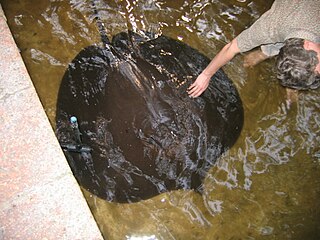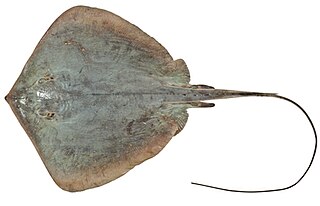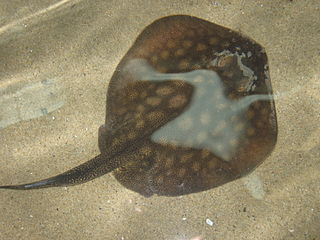
Stingrays are a group of sea rays, which are cartilaginous fish related to sharks. They are classified in the suborder Myliobatoidei of the order Myliobatiformes and consist of eight families: Hexatrygonidae, Plesiobatidae, Urolophidae (stingarees), Urotrygonidae, Dasyatidae, Potamotrygonidae, Gymnuridae and Myliobatidae . There are about 220 known stingray species organized into 29 genera.

River stingrays or freshwater stingrays are Neotropical freshwater fishes of the family Potamotrygonidae in the order Myliobatiformes, one of the four orders of batoids, cartilaginous fishes related to sharks. They are found in rivers in tropical and subtropical South America. A single marine genus, Styracura, of the tropical West Atlantic and East Pacific are also part of Potamotrygonidae. They are generally brownish, greyish or black, often with a mottled, speckled or spotted pattern, have disc widths ranging from 31 to 200 centimetres (1.0–6.6 ft) and venomous tail stingers. River stingrays feed on a wide range of smaller animals and the females give birth to live young. There are more than 35 species in five genera.

The sixgill stingray is a species of stingray and the only extant member of the family Hexatrygonidae. Although several species of sixgill stingrays have been described historically, they may represent variations in a single, widespread species. This flabby, heavy-bodied fish, described only in 1980, is unique among rays in having six pairs of gill slits rather than five. Growing up to 1.7 m (5.6 ft) long, it has a rounded pectoral fin disc and a long, triangular, and flexible snout filled with a gelatinous substance. It is brownish above and white below, and lacks dermal denticles.

The deepwater stingray or giant stingaree is a species of stingray and the sole member of the family Plesiobatidae. It is widely distributed in the Indo-Pacific, typically over fine sediments on the upper continental slope at depths of 275–680 m (900–2,230 ft). This species reaches 2.7 m (8.9 ft) in length and 1.5 m (4.9 ft) in width. It has an oval pectoral fin disc with a long, flexible, broad-angled snout. Most of the entire latter half of its tail supports a distinctively long, slender, leaf-shaped caudal fin. Its coloration is dark above and white below, and its skin is almost completely covered by tiny dermal denticles.

The short-tail stingray or smooth stingray is a common species of stingray in the family Dasyatidae. It occurs off southern Africa, typically offshore at a depth of 180–480 m (590–1,570 ft), and off southern Australia and New Zealand, from the intertidal zone to a depth of 156 m (512 ft). It is mostly bottom-dwelling in nature and can be found across a range of habitats from estuaries to reefs, but also frequently will swim into open water. One of the largest stingrays in the world, this heavy-bodied species can grow upwards of 2.1 m (6.9 ft) across and 350 kg (770 lb) in weight. Its plain-colored, diamond-shaped pectoral fin disc is characterized by a lack of dermal denticles even in adults, and white pores beside the head on either side. The body can have colors as well as dark grey or black with rows of white spots along each wing. Its tail is usually shorter than the disc and thick at the base. It is armed with large tubercles and a midline row of large thorns in front of the stinging spine which has the dorsal and ventral fin folds behind.

The ocellate river stingray, also known as the peacock-eye stingray or black river stingray, is a species of freshwater stingray in the family Potamotrygonidae. It was the first species to be described in the family and is also the most widespread, ranging throughout much of the Río de la Plata, Amazon, Mearim and Orinoco basins in tropical and subtropical South America. It is sometimes kept in aquaria.

The giant freshwater stingray is a species of stingray in the family Dasyatidae. It is found in large rivers and estuaries in Southeast Asia and Borneo, though historically it may have been more widely distributed in South and Southeast Asia. The largest freshwater fish and the largest stingray in the world, this species grows up to 2.2 m (7.2 ft) across and can reach up to 300 kg (660 lb) in weight. It has a relatively thin, oval pectoral fin disc that is widest anteriorly, and a sharply pointed snout with a protruding tip. Its tail is thin and whip-like, and lacks fin folds. This species is uniformly grayish brown above and white below; the underside of the pectoral and pelvic fins bear distinctive wide, dark bands on their posterior margins.

Kuhl's maskray, also known as the blue-spotted stingray, blue-spotted maskray, or Kuhl's stingray, is a species of stingray of the family Dasyatidae. It was recently changed from Dasyatis kuhlii in 2008 after morphological and molecular analyses showed that it is part of a distinct genus, Neotrygon. The body is rhomboidal and colored green with blue spots. Maximum disk width is estimated 46.5 cm (18.3 in). It is popular in aquaria, but usually not distinguished from the blue-spotted ribbontail ray. The ribbontail has a rounded body, is a brighter green with brighter blue and more vivid spots, but Kuhl's maskray is larger. The stingray's lifespan is estimated at 13 years for females and 10 years for males. The blue-spotted stingray preys on many fish and small mollusks. It is also generally found from Indonesia to Japan, and most of Australia. Kuhl's maskray also is targeted by many parasites, such as tapeworms, flatworms, and flukes.

The plain maskray or brown stingray, is a species of stingray in the family Dasyatidae. It is found in shallow, soft-bottomed habitats off northern Australia. Reaching 24 cm (9.4 in) in width, this species has a diamond-shaped, grayish green pectoral fin disc. Its short, whip-like tail has alternating black and white bands with fin folds above and below. There are short rows of thorns on the back and the base of the tail, but otherwise the skin is smooth. While this species possesses the dark mask-like pattern across its eyes common to its genus, it is not ornately patterned like other maskrays.

The estuary stingray, also called the estuary stingaree or brown stingray, is a species of stingray in the family Dasyatidae. Endemic to eastern Australia, it typically inhabits shallow, mangrove-lined tidal rivers, estuaries, and bays in southern Queensland and New South Wales. This yellow-brown to olive ray grows to at least 93 cm (37 in) across. It has a diamond-shaped pectoral fin disc and a mostly smooth, whip-like tail bearing both dorsal and ventral fin folds. It can additionally be identified by its long, narrow nostrils and the row of thorns along the midline of its back.

The round stingray or Haller's round ray and Little round stingray is a species of round ray, family Urotrygonidae, found in the coastal waters of the tropical and subtropical parts of the northeastern Pacific Ocean. It is a small, common ray that feeds mostly on benthic invertebrates. On the beaches of southern California, it is responsible for numerous injuries to bathers, who are stung when they accidentally step on the fish. The wound caused by its venomous spine can be painful, but is non-fatal.

Neotrygon is a genus of stingrays in the family Dasyatidae commonly known as the Maskrays, native to the Indo-West Pacific. They are so named because of a distinctive color pattern around their eyes, resembling a mask. The species in this genus were originally placed in the genus Dasyatis by most authors. However, recent morphological and molecular analyses have conclusively showed that they represent a distinct group and so the genus Neotrygon was resurrected for them.

The common stingray is a species of stingray in the family Dasyatidae, found in the northeastern Atlantic Ocean and the Mediterranean and Black Seas. It typically inhabits sandy or muddy habitats in coastal waters shallower than 60 m (200 ft), often burying itself in sediment. Usually measuring 45 cm (18 in) across, the common stingray has a diamond-shaped pectoral fin disc slightly wider than long, and a whip-like tail with upper and lower fin folds. It can be identified by its plain coloration and mostly smooth skin, except for a row of tubercles along the midline of the back in the largest individuals.

The whiptail stingrays are a family, the Dasyatidae, of rays in the order Myliobatiformes. They are found worldwide in tropical to temperate marine waters, and a number of species have also penetrated into fresh water in Africa, Asia, and Australia. Members of this family have flattened pectoral fin discs that range from oval to diamond-like in shape. Their common name comes from their whip-like tails, which are much longer than the disc and lack dorsal and caudal fins. All whiptail stingrays, except the porcupine ray, have one or more venomous stings near the base of the tail, which is used in defense. In order to sting their victims, they jerk their tails as the stinger falls off and stays in the wound that they have created. The stinger of a whiptail stingray is pointy, sharp with jagged edges. They range in size from 0.18 to 2.0 m or more across in the case of the smalleye stingray and giant freshwater stingray.

The daisy stingray, Fontitrygon margarita, is a little-known species of stingray in the family Dasyatidae, found in shallow waters along the coast of West Africa. This species typically grows to 60 cm (24 in) across and has a rounded pectoral fin disc and a wide band of dermal denticles over its back. It is characterized by a greatly enlarged, nacreous denticle in the middle of its back called a "pearl spine"; this feature is shared with the similar but much smaller pearl stingray, which has often been confused with this species. The daisy stingray feeds mainly on crustaceans and exhibits aplacental viviparity, with litters of 1–4 young. Heavily pressured by fisheries and possibly habitat degradation, this once-common species is declining and has been assessed as Vulnerable by the International Union for Conservation of Nature (IUCN).
Brown stingray may refer to:

The peppered maskray or speckled maskray, is a species of stingray in the family Dasyatidae, found in shallow waters off northeastern Australia. This small, thin-bodied ray attains a maximum width of 32 cm (13 in). It has a diamond-shaped pectoral fin disc with a row of tiny thorns along the midline, and a relatively short, whip-like tail with both upper and lower fin folds. Its upper surface has a speckled color pattern consisting of black spots and brownish reticulations on a light yellow to brown background.

The Ningaloo maskray is a species of stingray in the family Dasyatidae, found along the northwestern coast of Australia. Measuring up to 30 cm (12 in) across, it has a diamond-shaped pectoral fin disc with a blunt snout and rounded outer corners. Its tail is whip-like with both upper and lower fin folds. This species has a distinctive dorsal color pattern consisting of numerous small, sharp-edged deep orange spots and slightly larger, fuzzy-edged pale blue spots on a yellowish brown background.
Bluespotted stingray or blue-spotted stingray may refer to several species:
















